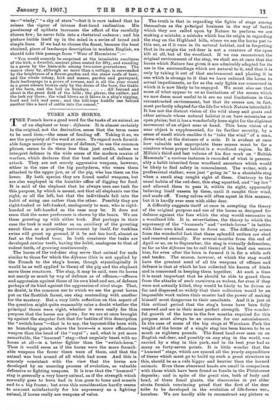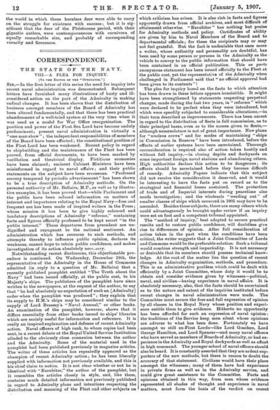TUSKS AND HORNS.
THE French have a good word for the tusks of an animal, as of an elephant or boar : defenses. It is almost certainly in the original, not the derivative, sense that the term came to be used thus,—the sense of fending off. Taking it so, we see the propriety of the word at once. To regard such formid- able fangs merely as " weapons of defence," to use the common phrase, seems to do them leas than just credit, unless we interpret defence in the wide sense of the modern maxim of warfare, which declares that the best method of defence is attack. They are not merely aggressive weapons, however, either in the case of the big pachyderm, who wears them attached to the upper jaw, or of the pig, who has them on the lower. By both species they are found useful weapons, but are also employed in the humbler office of digging for food. It is said of the elephant that he always uses one tusk for this purpose, by which is meant, not that all elephants use the right, or all the left, but that the individuals fall into the habit" of using one rather than the other. Possibly they are right-tusked or left-tusked, analogously to man, who is right- handed or left-handed as the case may be. It does not seem that the same preference is shown by the boars. We see them grouting up with either tusk. But perhaps in their case the tusk is used rather as an auxiliary of the grouting snout than as a grouting instrument by itself, for tuskless swine will grout up ground, if it be not too hard, almost as fast as the tusked boar. In both creatures the tusks are developed canine teeth, having the habit, analogous to that of rodent teeth, of growing continuously.
The horns of the red-deer stag serve that animal for ends similar to those for which the defenses (this is not applied by the French to the stag's horns, though etymologically it would be as well applied to them) of the pig and the elephant serve these creatures. The stag, it may be said, uses its horns not nearly so much by way of defence as of offence,—offence and aggression against those of its own kind and sex, of defence perhaps of its kind against the aggression of rival stags. That, no doubt, is the common use to which we see the great horns put on the Scottish forest, one stag contending with another for the mastery. But a very little reflection on this aspect of the question might quite reasonably raise a doubt whether the principal thesis were right, whether it were really for this purpose that the horns are given ; for we are at once brought up against the singular fact that for battles of this description the "switch-horn "—that is to say, the bayonet-like horn with no branching points above the brow—is a more efficacious weapon than the head of the "royal "; and, what is yet more remarkable, the "hnnimel " stag—that ungainly beast with no horns at all—is a better fighter than the "switch-horn." Thus it would seem as if the horns were the more formid- able weapons the fewer there were of them, and that the animal was best armed of all which bad none. And this is scarcely consistent with the view that the horns are developed by an unerring process of evolution, as valuable defensive or fighting weapons. It is true that the " hummel" stag is generally a very heavy animal, as if the strength which normally goes to born had in him gone to bone and muscle and to a big frame ; but even this consideration hardly seems to account satisfactorily for his supremacy as a fighting animal, if horns really are weapons of value. The truth is that in regarding the fights of stags among themselves as the principal business in the way of battle which they are called upon by Nature to perform we are making a mistake, a mistake which has its origin in regarding the stag on the Highland hills, where we see the horns put to this use, as if it were in its natural habitat, and in forgetting that in its origin the red-deer is not a creature of the open bill at all, but of the woodland. If we can reconstruct the original environment of the stag, we shall see at once that the horns which Nature has given it are admirably adapted for its use in the surroundings which are natural to it, and that it is only by taking it out of that environment and placing it in one which is strange to it that we have reduced the horns to actual impedimenta, so far as the only fights are concerned in which it is now likely to be engaged. We must also see that some of what appear to us as limitations of the senses which we now deem moat useful to it are no real limitations in this reconstructed environment, but that its senses are, in fact, most perfectly adapted for the life for which Nature intended it. It Las not the distant vision of the wild sheep and goats and other animals whose natural habitat is on bare mountains or open plains; but it has a wonderfully keen sight for the slightest movement of an object near at hand. This keen vision of a near object is supplemented, for its further security, by a sense of smell which enables it to "take the wind" of a man, down-wind, at the distance of a mile. It is evident at once how valuable and appropriate these senses must be for a creature whose proper habitat is a woodland region. In Mr. Millais's third and last volume of his fine work on " British Mammals" a curious instance is recorded of what is presum- ably a habit inherited from woodland ancestors which would be likely to find safety in concealment. The writer, with a professional stalker, were just " going in" to a sbootable stag when a small stag caught sight of them. Contrary to the usual habits of the red-deer, this stag squatted, and "lay low" and allowed them to pass it, within its sight, apparently believing itself unseen by them, until it caught their wind, and made off. Young calves will often squat in this manner, but it is hardly ever seen with older deer.
A difficulty suggests itself at once in accepting the theory of the original purpose and use of the horns as designed for defence against the foes which the stag would encounter in a woodland life. It is, nevertheless, the theory to which the supremacy of the " hummels" and "switch-horns" in battles with their own kind seems to force us. The difficulty arises from the wonderful fact that these splendid antlers are shed and renewed annually. POI' several months from the end of April or so, on to September, the stag is virtually defenceless, so far as the defenses (so to call them) of his head can secure Lim, for even after the horn is formed it is for a while soft and tender. The season, however, at which the stag would have the greatest need of all his weapons of offence and defence is that at which he has collected his harem of hinds and is concerned in keeping them together. At such a time it is most important that he should be able to guard them from the attacks of such carnivora as wolves, for even if they were not actually killed, they would be likely to be driven so far and dispersed so widely that their collection would be an impossible work unless their master bad the power of making himself most dangerous to their assailants. And it is just at this critical period that the stag's horns have been fully renewed and are in their most perfect strength. The wonder- ful growth of the horn in the few months required for this purpose must always be an occasion for our astonishment. In the case of some of the big stags at Warnbam Park the weight of the horns of a single stag has been known to be as much as eighteen pounds. The finest head ever seen on an English red-deer, and possibly on any stag in the world, was carried by a stag in this park, and in its best year had as many as forty-seven points. It is little wonder that the "hummer stags, which are spared all the yearly expenditure of tissue which must go to build up such a great structure as this, should be as a rule bigger and heavier than the horned animals. Even these abnormal heads are small in comparison with those which have been found as fossils in the Pleistocene deposits; and in spite of the great size, both of body and head, of these fossil giants, the discoveries in yet older strata furnish convincing proof that the first of the deer tribe to be developed in the evolution of life-forms wen. hornless. We are hardly able to reconstruct any picture ex
the world in which these hornless deer were able to carry on the struggle for existence with success ; but it is sig- nificant that the deer of the Pleistocene period, with their gigantic antlers, were contemporaneous with carnivora of equally remarkable size, and probably of corresponding voracity and fierceness.















































 Previous page
Previous page